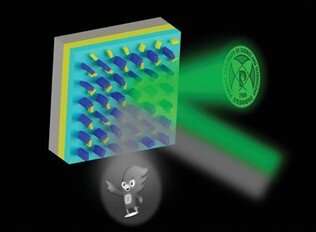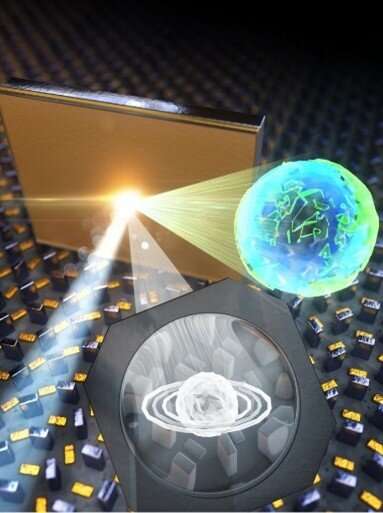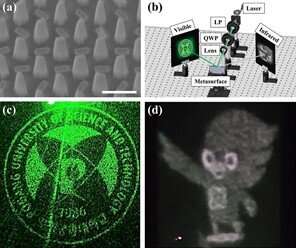Preventing data leak with dual-band metahologram

New frontiers have opened in the world of preventing data breaches by using light of two different wavelengths—visible and infrared light. This is achieved by using a new material called a metasurface that makes extreme use of properties of light. Using this technology, security is enhanced by storing information that needs to be concealed separately.
A POSTECH research team led by Professor Junsuk Rho of the Department of Mechanical Engineering and Chemical Engineering, Dr. Inki Kim of the Department of Mechanical Engineering (currently assistant professor of the Department of Biophysics at Sungkyunkwan University), and Ph.D. candidates Heonyeong Jeong and Joohoon Kim of the Department of Mechanical Engineering has developed an anticounterfeit technology that works simultaneously in visible and infrared domains using heterogenous meta-atoms. A meta-atom is the basic unit of a metasurface.
Until now, most metasurface devices were limited in that they are activated only in one of the narrow wavelength bands of visible or infrared domains. Even multiplexed-metaholograms often require optical setups to observe the encoded visual information.
To solve this problem, the research team used meta-atoms of different materials—specifically silicon and gold—to control the phase of the visible light of 532 nm and infrared light of 980 nm, respectively. As a result, different meta-atoms produced holographic images of each wavelength with high efficiency in both visible and infrared light.

Using this newly developed metasurface device, an infrared holographic image invisible to the naked eye appears along with a green holographic image when visible light and infrared lasers are irradiated. Here, the primary information is encrypted in a holographic image in the visible domain, while the secondary information is stored in the infrared domain. The secondary information can be observed with an infrared sensor card.
Using this new technology can further enhance the security of anticounterfeit technologies. Silicon and gold meta-atoms can control a variety of visible and infrared light in addition to wavelengths of 532 nm and 980 nm. Therefore, information that needs to be disclosed can be displayed as a visible light hologram, and information that needs to be hidden can be displayed as an infrared hologram. In other words, this technology can double-protect the information with one security card.

"We have demonstrated a technology that was only possible with two metasurfaces with just one silicon and gold-based metasurface," explained Professor Rho. "It is significant in that this new technology is applicable in advanced anticounterfeit technologies."
This study was conducted with the grant from the Samsung Research Funding & Incubation Center for Future Technology and was recently published as the inside front cover paper of Advanced Optical Materials.
More information: Inki Kim et al, Dual‐Band Operating Metaholograms with Heterogeneous Meta‐Atoms in the Visible and Near‐Infrared, Advanced Optical Materials (2021). DOI: 10.1002/adom.202100609
Journal information: Advanced Optical Materials
Provided by Pohang University of Science & Technology (POSTECH)



















